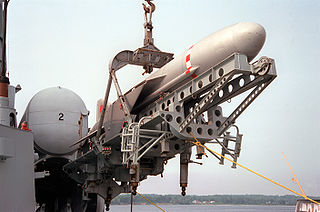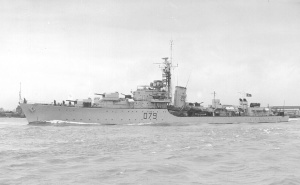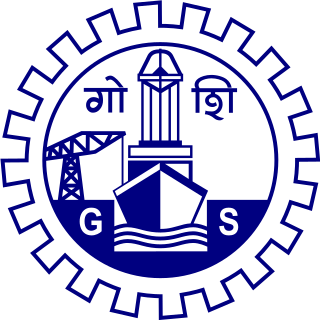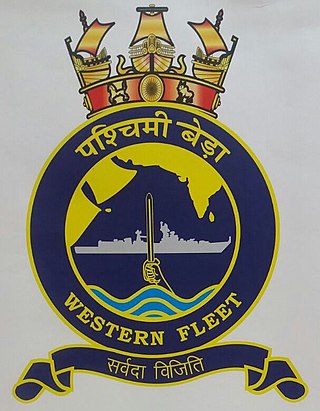
A corvette is a small warship. It is traditionally the smallest class of vessel considered to be a proper warship. The warship class above the corvette is that of the frigate, while the class below was historically that of the sloop-of-war.

HMS Charity was a C-class destroyer of the Royal Navy laid down by John I. Thornycroft and Company of Woolston, Southampton on 9 July 1943. She was launched on 30 November 1944 and commissioned on 19 November 1945. She was sold to the US Navy in 1958, for transfer to the Pakistan Navy as a part of the Military Aid Program.

The P-15 Termit is an anti-ship missile developed by the Soviet Union's Raduga design bureau in the 1950s. Its GRAU designation was 4K40, its NATO reporting name was Styx or SS-N-2. China acquired the design in 1958 and created at least four versions: the CSS-N-1 Scrubbrush and CSS-N-2 versions were developed for ship-launched operation, while the CSS-C-2 Silkworm and CSS-C-3 Seersucker were used for coastal defence. Other names for this basic type of missile include: HY-1, SY-1, and FL-1 Flying Dragon, North Korean local produced KN-1 or KN-01, derived from both Silkworm variants and Russian & USSR P-15, Rubezh, P-20 P-22.

HMS Cadiz was a Battle-class destroyer of the Royal Navy. She was named after the Battle of Cádiz, in which the French besieged the Spanish town in 1810, which was eventually lifted in 1812 after the French defeat at the Battle of Salamanca.

The Soviet designation Project 1241 Molniya are a class of Russian missile corvettes. They have the NATO reporting name Tarantul. These ships were designed to replace the Project 205M Tsunami missile cutter.

Operation Trident was an offensive operation launched by the Indian Navy on Pakistan's port city of Karachi during the Indo-Pakistani War of 1971. Operation Trident saw the first use of anti-ship missiles in combat in the region. The operation was conducted on the night of 4–5 December and inflicted heavy damage on Pakistani vessels and facilities. While India suffered no losses, Pakistan lost a minesweeper, a destroyer, a cargo vessel carrying ammunition, and fuel storage tanks in Karachi. Another destroyer was also badly damaged and eventually scrapped. India celebrates its Navy Day annually on 4 December to mark this operation. Trident was followed up by Operation Python three days later.
Operation Python, a follow-up to Operation Trident, was the code name of a naval attack launched on West Pakistan's port city of Karachi by the Indian Navy during the Indo-Pakistani War of 1971. After the first attack during Operation Trident on the Port of Karachi, Pakistan stepped up aerial surveillance of its coast as the presence of large Indian Navy ships gave the impression that another attack was being planned. Pakistani warships attempted to outsmart the Indian Navy by mingling with merchant shipping. To counter these moves, Operation Python was launched on the night of 8/9 December 1971. A strike group consisting of one missile boat and two frigates attacked the group of ships off the coast of Karachi. While India suffered no losses, Pakistani fleet tanker PNS Dacca was damaged beyond repair, and the Kemari Oil Storage facility was lost. Two other foreign ships stationed in Karachi were also sunk during the attack.

The Project 205 Moskit (mosquito) more commonly known by their NATO reporting name Osa, are a class of missile boats developed for the Soviet Navy in the late 1950s. Until 1962 this was classified as a large torpedo boat.

Goa Shipyard Limited (GSL) is an Indian Government owned ship building company located on the West Coast of India at Vasco da Gama, Goa. It was established in 1957, originally by the colonial government of the Portuguese in India as the "Estaleiros Navais de Goa", to build barges to be used in Goa's growing mining industry, which took off after the establishment of India's blockade of Goa in 1955. In the wake of Portugal's defeat and unconditional surrender to India following the 1961 Indian annexation of Goa, it was requisitioned to manufacture warships for the Indian Navy and the Indian Coast Guard.
INS Ajay (P34) was an Abhay-class corvette, in service with the Indian Navy. She inherited her name from INS Ajay, the first warship built in independent India, which served in the Navy from 1960–1974.
INS Nipat (K86) was a Vidyut-class missile boat of the Indian Navy. It was part of the 25th "Killer" Missile squadron.
INS Nirghat (K89) was a Vidyut-class missile boat of the Indian Navy.
The following ships of the Indian Navy have been named INS Pralaya:
Lt. Com. Bahadur Nariman KavinaVrC was a prominent Indian naval officer, who was commanding officer of the INS Nipat. During the Indo-Pakistani War of 1971, Kavina was the chief architect of attack on the Port of Karachi and led the successful attack on Pakistani Navy headquarters.

Vice Admiral Suraj Berry, AVSM, NM, VSM is a serving Flag officer in the Indian Navy. He currently serves as the Commander-in-Chief, Strategic Forces Command. He previously served as the Chief of Personnel, as the Controller of Personnel Services and as Chief of Staff of the Andaman and Nicobar Command. He has also commanded the Eastern Fleet and was the Commissioning Commanding Officer of the aircraft carrier INS Vikramaditya.

The Western Fleet is a Naval fleet of the Indian Navy. It is known as the 'Sword Arm' of the Indian Navy. It is headquartered at Mumbai, Maharashtra on the west coast of India. It is a part of the Western Naval Command and is responsible for the naval forces in the Arabian Sea and parts of the Indian Ocean.
Vice Admiral Elenjikal Chandy Kuruvila, PVSM, AVSM was a former Flag officer in the Indian Navy. He was the Fleet commander of the Western Fleet during the Indo-Pakistani War of 1971, for which he was awarded the Param Vishisht Seva Medal. He later led the Southern Naval Area and then served as the Chairman and Managing Director of Mazagon Dock Limited.

Rear Admiral Puneet Chadha, VSM is a serving flag officer of the Indian Navy. He currently serves as the Additional Director General of the National Cadet Corps. He previously served as the Flag Officer Commanding Tamil Nadu & Puducherry Naval Area (FOTNA) and as the Deputy Commandant of the Indian Naval Academy. As the last commanding officer of the aircraft carrier INS Viraat (R22), he decommissioned the carrier in 2017.

Rear Admiral Kunnisery Mallath Ramakrishnan, VSM is a serving Flag officer in the Indian Navy. He currently serves as the Flag Officer Commanding Karnataka Naval Area. He earlier served as the Assistant Chief of Naval Staff at Naval Headquarters.














